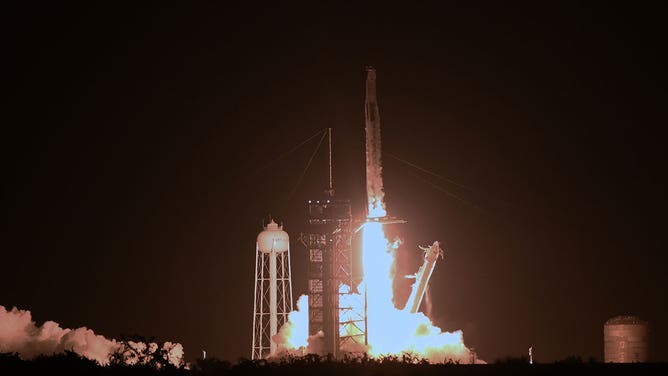SpaceX launches Polaris Dawn mission from Florida after multiple weather delays
Initially planned to launch on Aug. 27, the Polaris Dawn mission faced weather and technical delays. The company skipped any launch attempts last week as days of storms would have prevented a safe splashdown for the Dragon on either Florida coast in the event of a launch abort.
SpaceX launches billionaire's private crew on milestone spacewalk mission
SpaceX launched the Polaris Dawn mission, the first private spacewalking mission, after multiple delays due to Florida's recent rainy weather pattern.
KENNEDY SPACE CENTER, Fla. – SpaceX launched the Polaris Dawn mission on Tuesday morning, the first private spacewalking mission, after multiple delays due to Florida's recent rainy weather pattern.
SpaceX said the Crew Dragon spacecraft carrying Mission Commander Jared Isaacman, Mission Pilot Scott Poteet and SpaceX employees Sarah Gillis and Anna Menon was launched into low-Earth orbit at 5:23 a.m. ET from NASA's Kennedy Space Center launchpad 39A.

A SpaceX Falcon 9 rocket with the Crew Dragon spacecraft launches from pad 39A at the Kennedy Space Center on September 10, 2024 in Cape Canaveral, Florida.
(Paul Hennesy/Anadolu / Getty Images)
Initially planned to launch on Aug. 27, the Polaris Dawn mission faced weather and technical delays. The company skipped any launch attempts last week as days of storms would have prevented a safe splashdown for the Dragon on either Florida coast in the event of a launch abort.
"The primary factor driving the launch timing for Polaris Dawn is the splashdown weather within Dragon's limits. Unlike an ISS mission, we don’t have the option to delay long on orbit, so we must ensure the forecast is as favorable as possible before we launch," Isaacman recently wrote on X.
According to SpaceX, Falcon 9's first stage returned to Earth and landed on the company's droneship stationed in the Atlantic Ocean.
After reaching an orbit about 870 miles above Earth, the company said the crew began doing scientific experiments and testing the Starlink internet connection.
SpaceX said the spacecraft will undergo a two-day "pre-breathe process," allowing the crew to adjust to zero gravity before the planned spacewalk on Thursday.
What is the Polaris Dawn mission?
Polaris Dawn is part of a series of private spaceflights funded by Isaacman, an American businessman and founder of Shift4Payment. This will be Isaacman's second spaceflight. In 2021, he funded and flew on a SpaceX spaceflight known as Inspiration4 with three other private astronauts.
The ambitious private mission has many goals, including a series of spaceflight firsts for private citizens and SpaceX.

Anna Menon during Polaris Dawn EVA spacesuit acceptance testing at Johnson Space Center in Houston.
(Polaris Program / John Kraus)
After launch, the SpaceX Dragons reached an altitude of nearly 870 miles above Earth (1,400 kilometers), higher than any human spaceflight since the Apollo program. This will take them through part of one of the Van Allen Radiation belts, and the deeper orbit is more than three times farther than the International Space Station.
"The Polaris Program astronaut mission is headed for an altitude 3 times higher than the Space Station, the furthest that humans have been from Earth in over half a century!" SpaceX Founder Elon Musk wrote on X after the launch.
The second major objective of the mission is completing the first commercial spacewalk at 430 miles above Earth using the newly developed SpaceX microgravity spacesuits. The extravehicular activity, or EVA, suits look similar to the black-and-white flight suits the astronauts wear for launch but with the addition of life-support systems, temperature control and communication.
On the third day in space, two space flyers will remain in the spacecraft, but all four will be exposed to the vacuum of space, requiring spacesuits for everyone.
The mission will last about six days and culminate in a Dragon splashdown in one of seven locations around Florida.
In the coming years, the Polaris Program will conclude with a human spaceflight on SpaceX's Starship, which is still under development in Texas.
